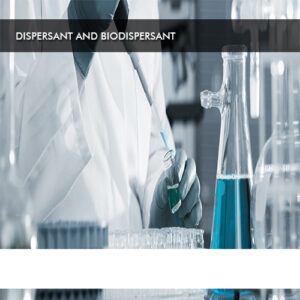Biodispersent
Biodispersants, also known as bio-based dispersants or biodegradable dispersants, are a specific type of dispersing agent that is derived from renewable or biodegradable sources. Biodispersants offer similar functionality to conventional dispersants but with the added benefit of being more environmentally friendly. Here are some details about biodispersants:
Biodispersants work by facilitating the dispersion of solid particles or liquid droplets within a liquid medium. They help prevent the agglomeration or settling of particles, ensuring a stable and homogeneous dispersion. Here is an overview of how biodispersants work:

Environmental Sustainability:
Biodispersants are designed to have reduced environmental impact compared to conventional dispersants. They are typically derived from renewable resources, such as plant-based or bio-based materials, and are biodegradable. This means that they can break down naturally in the environment, reducing potential long-term environmental accumulation.
Dispersion Performance:
Biodispersants are formulated to effectively disperse solid particles or liquid droplets in a liquid medium, similar to conventional dispersants. They help prevent agglomeration, flocculation, or settling of particles, ensuring a homogeneous dispersion.
Application Range:
Biodispersants can be used in various industries and applications where dispersants are required. This includes paints and coatings, inks, adhesives and sealants, ceramics, personal care products, and more. They provide similar benefits as conventional dispersants in terms of improved stability, uniformity, and performance of the formulated products.
Biodegradability:
One of the key advantages of biodispersants is their biodegradability. They are designed to break down into natural components through microbial or enzymatic processes, minimizing their environmental persistence and potential impact.
Regulatory Compliance:
Biodispersants may comply with specific environmental regulations and certifications related to sustainability and biodegradability. Different regions and countries may have their own standards and certifications for bio-based or environmentally friendly products.
Compatibility and Performance:
Biodispersants are formulated to be compatible with various systems and ingredients commonly used in the respective industries. They are designed to provide effective dispersion and stability while maintaining desired product performance and properties.
It’s important to note that the specific properties, performance, and applications of biodispersants may vary depending on the product formulation and manufacturer. It is advisable to consult product data sheets, technical information, and recommendations provided by the biodispersant manufacturer for optimal usage, dosage levels, and compatibility with other ingredients in your specific application.
Overall, biodispersants offer an eco-friendly alternative to conventional dispersants, allowing for improved dispersion performance while reducing potential environmental impacts.

